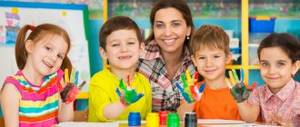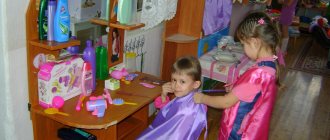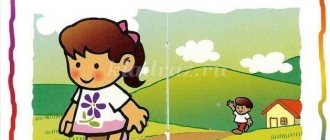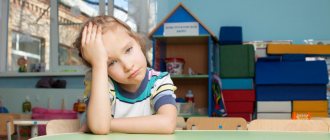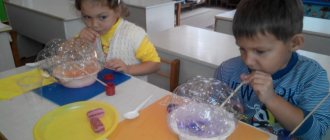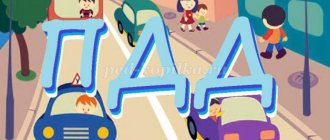“Mathematics must be taught first because it puts the mind in order,” everyone knows this statement by Lomonosov. In life, mathematics helps a person solve various kinds of problems, see the future, and plan his actions. Psychologists confirm that teaching children to count improves the functioning of all mental processes, develops logical thinking and intelligence. Children who can handle numbers and mathematical concepts do well in all subjects at school. Therefore, as soon as the baby grows up, caring parents immediately begin to teach him to count. However, teaching children at home requires special organization. It is important to know when and how to properly develop elementary mathematical concepts. According to experts, the age of 2-3 years is considered the best period to start learning. This is explained by the fact that children already have experience in understanding the world around them, understanding the speech of an adult, the ability to visually represent objects and associate mathematical concepts with them, for example: how many, one - many, more - less, equally. When parents ask where to start teaching their child, there is only one answer: learn to count from 1 to 5.
Counting items within 5
The main thing is that when teaching children to count within 5, adhere to the basic rules, then the work on developing elementary mathematical concepts will go much easier and faster. So, how to teach a child to count?
We follow the principles of learning
Adults should understand that young children are not always able to quickly master new knowledge. To ensure that children do not lose interest in classes due to the complexity of the material, training should proceed:
- from simple to complex;
- gradually and in stages;
- the duration of classes at the initial stage does not exceed 10 minutes;
- there is no need to burden the child with unnecessary information;
- it is necessary to constantly repeat the acquired knowledge.
The home learning program for counting within 5 consists of the following stages:
- Compiling the number of objects within 5 and counting them in forward and reverse order (first from 1 to 5, then from 5 to 1).
- Quantitative (question: how many objects?) and ordinal (question: which number?) counting within 5.
- Correlation of number and figure: we connect the auditory perception of a number with its designation (writing).
We prepare for a meaningful perception of mathematical knowledge
Teachers claim that even the smallest child can easily count objects: one, two, three, etc. This reassures parents, they think that their baby can count. However, often the baby simply repeats after the adult and mechanically remembers the names of numerals. Finding himself in different conditions, he may simply confuse them. Parents will understand whether their child is counting meaningfully if they change the conditions, for example, making up quantities from different toys, mixing them with household objects, counting drawn objects, counting sticks. For accurate perception and meaningful counting, you need to teach your child to act correctly: count objects by touching them with your hand, from left to right. When naming the last numeral, ask how many objects there are.
Do not forget! The numeral “one” cannot be replaced with the word “one”!
Counting forward and backward
When teaching your child quantitative calculation, it is important to show him that he can count forward and backward. Experts say such skills are necessary for further, more complex manipulations with numbers, such as learning to subtract. Simple games will help teach children how to count backwards within 5, for example: lay out a ladder of cubes, along which toys walk up and down, counting 1, 2, 3, 4, 5 and 5, 4, 3, 2, 1. Or play game “What has changed?” (the adult makes up a quantity of 5 small objects, the child counts them, concludes: there are only 5 toys. Then he closes his eyes, and the adult puts away the toy, the child counts and concludes: there are 4 toys in total, etc.).
We teach ordinal counting
After the baby masters quantitative counting, it is necessary to move on to ordinal counting. With this type of counting, each item receives its own serial number: first, second... You can count in order only from left to right. Finger games are useful in strengthening the skills of ordinal counting, for example, bending your fingers and counting with your child:
“The first finger is the largest, the index finger is the second, the third finger is the middle one, and the fourth is the ring finger, the fifth finger is our favorite, and its name is the little finger!”
Or “The first finger is grandpa, the second finger is grandma, the third finger is daddy, the fourth finger is mommy, the fifth finger is our baby and his name is (child’s name).”
The game “Which toy is missing?” will be useful. (each item is assigned a serial number: the first is a bear, the second is a ball, the third is an elephant, the fourth is a cube, the fifth is a house. Then the child closes his eyes, the adult hides one of the toys and asks which item is missing).
Connecting the number and the corresponding digit
Children can quickly learn to match number and number. Proper training is important, in which the best technique is when the baby is taught numerals and the corresponding numbers constantly, in everyday situations. For example, at home they count and number books, placing them in order; count the steps marked with numbers; pigeons on the playground, trees in the park. It is useful to create a problematic situation for the child by deliberately omitting some number, for example: “Let’s collect leaves for a bouquet, the first leaf, the second, ... the fourth. Right?" At the same time, pay attention that the number can be written down, look for numbers in surrounding objects: in books, house numbers, bus numbers.
Children's games, rhymes, and counting rhymes will help you remember the number meaningfully and connect it with the number. For example, to the words of S. Marshak: “Here is one or one, very thin, like a knitting needle. But this is number two. Admire how it looks: the deuce arches its neck, its tail drags behind it...” the adult lays out numbers from available material or draws them. You can draw the names of the kittens in numbers in S. Mikhalkov’s counting rhyme: “We decided, we wondered: what should we name the kittens? Finally we named them: One, Two, Three, Four, Five.” Or give the kids pictures with numbers and play: “We’ll run and play, I decided to count you: one, two, three, four, five...”.
Teaching actions with numbers
Memorizing numbers will go much faster if a preschooler learns to actively work with them, for example, adding. Children aged 2 to 3 years begin to add numbers only when they have mastered meaningful counting. There's no need to worry if your three-year-old doesn't understand addition yet. This skill requires knowledge of the composition of numbers; it can be formed later, by the age of four, which is also the norm. In order for the child to understand the composition of the number, counting sticks are used as a simulator: “Put one stick on the left and two on the right, how many are there in total?” What number did you get?
Ordinal counting up to 10 – Printable tasks in pictures
Contents
In these interesting tasks, children will learn what ordinal counting to 10 is. And those who are already familiar with this concept can show their knowledge with this exercise. The tasks are intended for children aged 5 years and older and are designed to prepare them for school. The child must perform all exercises independently under adult supervision (an adult reads the conditions, asks questions, and helps in case of difficulties).
Ordinal counting up to 10 – Distribute the dragonets
Here the child will have to determine the ordinal count up to 10 for each dragon in the row. According to the terms of the task, all 10 dragonets lined up in a row. And each dragonet has its own number - this is a serial count from left to right from 1 to 10. Then the dragonets were separated. The child needs to find each dragon in the general row, count and determine its serial number and write it in the empty cell next to the dragon.
You can download ordinal counting up to 10 with baby dragons (like all other tasks) in the attachments at the bottom of the page.
Ordinal Counting - Printable Activities
And you can view and download several more tasks for ordinal counting on this page. The download file is posted in word format so that you can print several task pages at once, rather than one picture at a time.
In this task, the child needs to enter the missing numbers in the circles in such a way that their ordinal count is preserved. To test the child's knowledge, three circles in a row are given, where one or two numbers are unknown. The child must fill in the missing ones. For children who do not yet know ordinal counting, you can give a hint by placing in front of them a sheet of paper with numbers from 1 to 10 in order in one row. Let the child look at the order in which the numbers are and write them into the assignment circles according to this principle.
These bright, cheerful pictures contain tasks for children that test their knowledge of ordinal counting up to 10. In the first task, you need to circle the second animal in each row. In the second task you need to circle the fourth mouse. In the third task, the child must circle the number between 6 and 8 with a green pencil, the number before the number 4 with a blue pencil, and the number after 9 with a red pencil. In the fourth task, all fallen flags must be returned to their places.
In the next task, the child will have to color the picture in accordance with its ordinal count. 1- Color the fifth mushroom. 2 – Color the seventh pear. 3 – Color the third umbrella. 4 – Color the sixth vase. 5 – Color the fourth snail.
In the first task you need to count the candies. Then color the first blue, the third green, the fourth red, the sixth yellow, the ninth pink, the tenth orange. In the second task you need to count the circles. Color every second circle yellow, every third circle blue. Why did one circle change color? What number is he? In the third task, paint the windows on the first floor blue, on the second floor yellow, on the third floor green, and on the fourth floor orange.
Here children must write numbers in the empty cells of the caterpillar in the order in which they were counted.
You can download all tasks for ordinal counting up to 10 in the attachments below. All pictures with tasks are in one Word file.
To make your classes more effective,
bibusha.ru
Teaching children to count to 5 in games
Teachers recommend that for teaching mathematics to bring tangible results, it must be accessible and interesting for the child.
A children's math game meets these educational requirements. Didactic (educational) games, for example, like the familiar lotto, dominoes, and puzzles, are particularly successful in mastering and consolidating mathematical knowledge. To consolidate new material, verbal and physical games, story-based and creative games are useful, which can be a good help for parents to practice their child’s counting.
Finger games for little ones
For the youngest children, finger games are suitable, which will serve not only as gymnastics for the small muscles of the hand, but also as a simulator for counting from 1 to 5. An adult invites the baby to work with his fingers to the rhythm of the verse: clench and unclench, alternately bend and count. Don't forget that we play with our fingers and learn to count to 5 together with the baby. Finger games will be interesting if you draw caps with funny faces for each finger or use a finger theater.
"Five fingers"
There are five fingers on my hand, five grippers, five holders. To plan and to saw, To take and to give. It's not hard to count them: One, two, three, four, five!
"Counting fingers"
Let's count our fingers: One, two, three, four, five. One, two, three, four, five, fingers began to play. Everyone is so friendly, strong and necessary
Mathematical games for counting
Any game can be a mathematical activity for preschoolers, the main thing is to comply with the necessary requirements. This activity will help children practice quantitative and ordinal counting, become familiar with numbers, mathematical concepts (one is many, more is less), and actively work with numbers.
"Our assistant"
Thematic actions allow the child to feel his importance in the family, enrich him emotionally, and at the same time strengthen his quantitative skills. The child, at the mother’s request, counts and lays out the required amount of cutlery for dinner. You can ask him to bring two cucumbers, three tomatoes, one pepper for the salad.
"Make a figure"
The task is used as a simulator for the development of fine motor skills, counting within 5, consolidation of numbers, names of geometric shapes. An adult prepares in advance several colored geometric shapes (square, circle), which are cut into 5 parts. Each part is marked with a corresponding number. The preschooler must pick up the pieces and count their number for each figure. For variety, you can offer a competition “Who can assemble the figure faster!” Be sure to give your child the opportunity to win and encourage him.
"Kids - pencils"
Preschool children become familiar with the composition of numbers from units and repeat quantitative calculation. Colored pencils are needed for this lesson. The adult takes out a blue pencil, clarifies that there is only one object, then another yellow pencil: the number 2 consists of two pencils (units). Gradually, other pencils are placed in order to similarly introduce the composition of subsequent numbers. At the end of the lesson, to maintain interest, the adult reads poetry based on the work of A. Stepanov, and the child draws a picture:
There are kids in the box, Kids - pencils. One, two, three, four, five, Let's start drawing. Red, yellow, blue... Choose any one for yourself. Draw a beautiful house, we will live with you in it. And draw the sun above the house, So that it shines for us in the window. And there are clouds in the sky, running towards us from afar. And below there is a stream, grass, and on a tree - foliage.
"Draw a number"
The task introduces preschool children to the composition of numbers, helps to correlate number and figure, and exercises quantitative calculations. An adult invites the child to “draw” a number from any objects: pencils, small toys, counting sticks, then count the number of objects.
"Locomotive"
In the story game, counting from 1 to 5 is practiced and ordinal is reinforced. It's good when the whole family plays. If this is not possible, large toys are used: bears, dolls, elephants. The adult arranges the chairs like a train, the child arranges the toys in order. You can ask if there is enough space for all passengers. The child counts chairs and toys. Then, accompanied by a cheerful song from the cartoon, the train sets off. The plot of the game could be like this: “Toys go on a journey. Count them and plant them in order: first, second, third, fourth, fifth.” You can diversify the action by attaching pictures with numbers to the chairs.
"Math Puzzles"
The game develops memory, attention, spatial thinking, and trains in memorizing numbers. It is very easy to prepare material for such a board game yourself: select pictures with large images, for example, vegetables, fruits, household items, houses. The pictures are cut into five parts, and each part is indicated by a number. The child must assemble the picture in accordance with the number series. In this game it is useful to learn to name the “neighbors” of a number (2’s “neighbors” are 1 and 3).
Children will quickly and easily learn to count if adults constantly exercise them!
Mathematics lesson according to the Federal State Educational Standard for children 4-5 years old
Goal: to consolidate children’s knowledge of quantitative and ordinal counting, the names of geometric figures, and time concepts. Objectives: - consolidation of knowledge of direct counting within five - the ability to find the next and previous number from the named and designated one - continue to learn how to correlate a number with the number of objects - distinguish between quantitative and ordinal counting within 5 - continue to learn how to make a figure from geometric figures - consolidation of knowledge in the names of the seasons, the time of day, the names of geometric figures Progress of the lesson (children sit in a semicircle on the carpet) A teacher enters in an astrologer costume, holding a magic wand. Q. Today our room is fabulous, and we will open the door to another, extraordinary, amazing world, which is full of miracles. Only those children who love to travel, fantasize and dream can enter this fairy-tale world. And I will help you with this - today I will be the wise Astrologer from the Planet of Wonders. I have been living on the Planet of Wonders for a long time. Over thousands of years I have seen a lot of unusual and interesting things. I have an old magic book where I write down extraordinary stories and fairy tales (opens the magic book). Listen to a fairy tale. In one star country there lived a king with his star queen and daughter, Princess Zvezdochka. He decided to somehow count everything in his country. He flew, flew through the sky, counted, counted... Returned home, the queen asked - “Well? Have you counted everything? The king doesn’t remember!.. The queen got angry, and the king was upset... Then the wise Astrologer tells him... What do you think the Astrologer advised? (answers and guesses from children) And the Astrologer tells him: “In order not to forget how many stars, clouds, birds, etc. there are in total, it was necessary to write down the numbers obtained when counting using numbers. Recounted and indicated the quantity with a number. After all, a number is a sign of a number.” Apparently the king doesn’t even know the numbers! Guys, let's help the king from the Star Country? Now I’ll wave my magic wand and turn you into Astrologer’s assistants and we’ll go to the magical Star Country. “Crible-crable-boom...” Come quietly into our magical room and sit down at the star tables. After all, you are now young stargazers. And the star country greets us with colored lights. The king left his portrait, and he is watching you through a celestial telescope. He thinks: will they cope or not?..2) GAME “COUNT THE OBJECTS” B. Look: the king left his cards, apparently he could not count. Count the objects on the card and indicate the number of objects with a number (children count the objects and put the desired number next to them). - How many Christmas trees? - How many mushrooms? (etc.) Did you count everything correctly? Who didn't succeed? How to count correctly? (The children, together with the teacher, recite the algorithm: when recounting, you must not miss a single item and not count a single item twice). I hear the king’s voice - he is very pleased with you. Well done.
2) GAME “THE NUMBERS ARE CONFUSED” (the teacher opens the curtain - there is a number row on the easel) Q. A stellar hurricane has apparently passed through this country. All the numbers are mixed up. Which number is out of place? (children's answer). Leila, put the number 2 in its place. You, too, put the numbers in order on your tables. Arranged? — What number comes before the number 3? — What number comes after the number 1? — What number is between the numbers 3 and 5? Right.
3) GAME “HIDE AND HIDE” B. Let’s play hide and seek with the numbers. Close your eyes. Open. What number is hidden? (3, because after the number 2 comes the number 3) (2-3 digits are also hidden). They played very well. It was fun and interesting.
4) GAME “HOUSES FOR STARS” (a star appears) V. Once upon a time there were stars. They lived as families. The families were different: in one family there lived one star, in other families there were more. All the stars lived on the same street. Let's help the stars settle correctly. What kind of house is this? Let's count in order (children name the serial numbers of the houses: first, second, third, fourth, fifth). Q. What do you think needs to be done to prevent the stars from forgetting which house they live in? (you need to place cards with a number. This will be the house number). We have attached the cards, now we will place stars. This is... (first house) - he will live here... (1 star). This is...(second house) - they will live here (2 stars), etc. Bring the stars, we'll count them and place them in your homes. Thank you. All the stars are happy now.
4) GAME “STARS AND CLOUDS” V. (opens a closed carpet panel). Guys, look how many beautiful stars there are here. We are stargazers. Let's count how many stars? (4 stars here). How many clouds? What more? How much more? Let's put each star to sleep on a cloud. Will there be enough clouds for all the stars? Why? What should be done? (add another cloud). The stars each rest on their own cloud. They probably have very beautiful colorful dreams.
5) PHYSICAL MINUTE “TIRED TOYS ARE SLEEPING” Q. We will also rest a little. Take these toys that we took with us so that we don't get bored. Close your eyes and listen to the song. This is the princess's favorite lullaby. (children lie down on the carpet with their toys - an audio recording of the song plays).
6) PHYSICAL “WHO LIVES FOR A MONTH?” B. The alarm clock is ringing - it’s time to get up. And this cute silver fox came to us and called us to do some exercise and warm-up. A month floats across the sky. Who lives during the month? (walking) A sly fox is walking there, He looks down at the ground. (lean forward) The fox waves its tail, its thick fur turns silver. (waving their hands behind their backs) And the stars fly around, They fly to visit the fox. (wave hands in front of themselves)
7) GAME “HIT THE TAMBERION” Q. I feel something is boring with the king’s talo (where he is hiding). Let's try to cheer him up. I have two ribbons - long and short. Which ribbon is the longest? (pink). Which tape is shorter? (yellow). A long ribbon means a loud blow, and a short ribbon means a quiet one. Prepare your tambourines, be careful, watch my actions. Okay, everyone was paying attention.
7) GAME “NAME THE PARTS OF THE DAY” Q. In the star country, time also does not stand still, the parts of the day replace each other (shows a poster) 1. Name the parts of the day (morning, afternoon, evening, night) 2. How many parts are there in a day? (four) 3.What is the name of the day that has passed? (yesterday) 4.What are the names of the days that are coming soon? (tomorrow) 5.What is the name of the day in which we live now, at the present moment? (today) Q. In our group we have a daily routine (shows a poster) -What comes first - lunch or dinner? -What’s later: a walk or breakfast? -Which comes first: afternoon tea or quiet time? Yes, everything is correct, everything is going correctly, one after another, just as parts of the day replace each other. One day passes, another comes. -Where do they run for days? (child recites a poem)
Morning, afternoon, evening, night, They ran away for a day. So as not to regret a day, You must take care of every day, So that you have time to dance and read. Draw, play with friends and help mom. V. Well done. Yes, time should be spent usefully and according to the schedule. And try to get everything done on time before it’s time to sleep at night.
 GAME “IN THE COUNTRY OF UNSOLVED MYSTERIES” Q. There are so many secrets in this starry country. Here's another secret. (knock on the door - they bring a magic chest). A strange chest - with a lock. Probably, the king came up with something again (opens the chest). The king sent us a letter: “Help, my princess Star is lost in time, guess the riddles about the seasons and she will return to her country again. King of the Star Country."
GAME “IN THE COUNTRY OF UNSOLVED MYSTERIES” Q. There are so many secrets in this starry country. Here's another secret. (knock on the door - they bring a magic chest). A strange chest - with a lock. Probably, the king came up with something again (opens the chest). The king sent us a letter: “Help, my princess Star is lost in time, guess the riddles about the seasons and she will return to her country again. King of the Star Country."
Guys, let's help the king? Can you guess the riddles? And here is our assistant picture (shows a table of mnemonics) (V. reads riddles about the seasons) 1) I have a lot to do: I cover the whole earth with a white blanket, I whiten the fields, houses, My name is... (winter). 2) I open the buds into green leaves, I dress the trees, I water the crops, I am full of movement. My name is...(spring). 3) I am woven from the heat, I carry warmth with me, I warm the rivers, swim - I invite you! And you all love me for this. I... (summer) 4) I bring the harvests, I sow the fields, I send the birds to the south, I strip the trees, But I did not touch the fir trees and pines. I... (autumn) (while solving riddles, children find and show pictures corresponding to each season). - How many seasons are there in total? -Name them. (the child reads a poem about the seasons) Winter comes to us first - it leads into the new year, After the second winter - spring, they say - spring is red, The third - summer, all in flowers, and with raspberries on the bushes, And the fourth - autumn, forest I threw off my outfit.
9) PUZZLE GAME B. The star hurricane not only mixed up the numbers, it also scattered parts of geometric shapes everywhere (parts of a square and a circle were scattered on the floor). How to collect them now? This is the puzzle. To complete the puzzle correctly, we will do the “Ear-Nose” exercise for the brain (children perform a kinesiological exercise). Who can help you fold geometric shapes? (children, if desired, assemble geometric shapes from 2, 3, 4 parts).
10) GAME “MAGICAL FIGURES” V. Guys, let us fantasize and come up with what magical creatures can live in this starry country. Create a variety of unusual silhouettes from the geometric shapes you have. (children make shapes) - What geometric shapes did you use? All the figures are wonderful. The most interesting, varied and successful ones are from Polina, Danila... Let's leave these figures as a gift to the princess.
11) GAME “THE PRINCESS’S GIFT” B. And here the princess left her gift for you (opens the blanket). A very beautiful pattern on a small piece of a star blanket. — What's in the upper right corner? -What's in the lower right corner? -What's in the upper left corner? - What's in the lower left corner? Right. Well done.
-Guys, where were we today? (in star country) -What did you do? (they counted, named numbers, made a magic figure, played, guessed riddles, named the parts of the day...) - What did you like? Now take your mood cards and fill in the mood circle: yellow for “I’m happy,” green for “I’m calm, interested,” and red for fear or sadness. And I'll see what mood you were in today.
(phone ringing) Q. Hello, is this the king? Say thank you very much to the guys. Sent the princess with gifts? Guys, Princess Zvezdochka is flying towards us any minute now. The king sent gifts and refreshments for you. (the princess comes in) Princess: Guys, you think so well and know so much, Thank you. And accept gifts from our family. We are waiting for you to visit us again. Goodbye. Q. Goodbye, princess. We will definitely try to fly to visit you. I will give you these gifts and it’s time for us to return (the teacher gives out prizes) Thank you, our journey is over. Now I’ll wave my wand: “Crible, crable, boom...”
Mental counting table for children in pictures
This page contains a table of mental calculations in pictures for printing. Children easily perceive counting to 10 in the form of a table, since here they clearly see the increase in the number of pictures with each subsequent number. The table is suitable both for home use for teaching counting to preschoolers, and as teaching material for teachers in kindergartens and primary schools.
Mental arithmetic table in pictures – Print and count
Here you can download an archive containing a mental counting table for children in two versions - with numbers from 1 to 10 and from 0 to 10. Print any of them (or two at once) on a color printer and use them in teaching with children. The table can be hung on the wall so that it is always in front of the child’s eyes. This way he can always return to it when he forgets the order of numbers or the number of objects in each number.
Have a lesson with your child. Let him count each column and answer the question: What changes with each subsequent column? (Answer - 1 item is added). Just keep in mind that the child must do this observation himself, without your prompting! In the same way, let him think about what changes with each column if objects are counted from right to left (Answer - there is 1 less object).
You can download the archive - Oral counting table - in the attachments at the bottom of the page
Table 1
table 2
You can find similar tasks teaching how to count to 10 in other materials:
Counting to 10 for preschool children
Children love to color and trace, so these activities will make your numeracy sessions as effective as possible.
Counting to 20 – Printable tasks in pictures
Count to 20 with fun printable activity sheets! All you need is to select any set of puzzles in pictures, download them as attachments and print them on a printer.
Mental counting within 10 – Pictures with tasks
In addition to the worksheets for learning to count, you'll also need our fun picture activities. Among them you will find many different game tasks that will train your child’s counting skills and instill a love of mathematics.
Coloring pages with tasks for counting within 10
So that children can quickly and with interest master counting within 10, we have prepared for you fun coloring pages with tasks. Each task contains pictures for coloring - this stimulates
bibusha.ru
